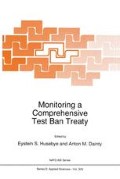Abstract
This lecture summarizes results from technical experiments conducted by the GSE (Group of Scientific Experts) in Geneva over the past 15 years. It shows the interrelation between conceptual design of an international seismic data exchange system and technical developments in instrumentation and communication channels. Although the GSE-experiments have given valuable experience in many technical aspects of a seismological monitoring system, a full scale test still awaits the existence of a calibrated station network.
With the experience from previous experiments, the GSE recently re-assessed the concept of the seismological monitoring system. The new concept includes: a single centralized international data centre (IDC); a specifically designed high-quality station network; and a modern communications system providing continuously waveform data to the IDC. To test this modernized concept, a very ambitious experiment (GSETT-3) has already started in 1993 with full-scale operational testing scheduled to begin in January 1995. GSETT-3 will be an unprecedented global effort to conduct an operationally realistic test of rapid data collection, distribution and processing. Previous GSE experiments have shown, however, that the use of modern technology does not necessarily improve the seismological results. Lessons learned from the seismological evaluation of GSETT-2 should be reminded. The most important aspect is that the seismological monitoring system can evolve. The system evolution will not be restricted to technical elements but it will also include improvements in the seismological capabilities when the station network has been calibrated with respect to global and regional travel-time curves and amplitudedistance relations. Other areas where further work is needed, include enhancement of phase identification and phase association, event location procedures and event characterization.
Access this chapter
Tax calculation will be finalised at checkout
Purchases are for personal use only
Preview
Unable to display preview. Download preview PDF.
References
CCD/558: Report to the Conference on Disarmament of the Ad Hoc Group of Scientific Experts to Consider International Co-operative Measures to Detect and to Identify Seismic Events, Geneva, 8 March 1978.
CD/43: Second Report of the Ad Hoc Group of Scientific Experts to Consider International Co-operative Measures to Detect and Identify Seismic Events, Geneva, 23 July 1979.
CD/448: Third Report to the Conference on Disarmament of the Ad Hoc Group of Scientific Experts to Consider International Co-operative Measures to Detect and Identify Seismic Events, Geneva, 9 March 1984.
CD/720: Fourth Report to the Conference on Disarmament of the Ad Hoc Group of Scientific Experts to Consider International Co-operative Measures to Detect and Identify Seismic Events: Report on the Group of Scientific Experts’ Technical Test (GSETT) 1984, Geneva, 31 July 1986.
CD/903: Fifth Report to the Conference on Disarmament of the Ad Hoc Group of Scientific Experts to Consider International Co-operative Measures to Detect and Identify Seismic Events: Technical Concepts for a Global System for International Seismic Data Exchange, Geneva, 17 March 1989.
CD/1144: Sixth Report to the Conference on Disarmament of the Ad Hoc Group of Scientific Experts to Consider International Co-operative Measures to Detect and Identify Seismic Events: Report on the Group of Scientific Experts’ Second Technical Test (GSETT-2), Geneva, 13 March 1992.
GSE/35/CRP 228: Report on the Seismological Evaluation of the Group of Scientific Experts’ Second Technical Test (GSETT-2), Geneva, 2 March 1993.
CD/1254: Report of the Ad Hoc Group of Scientific Experts to Consider International Co-operative Measures to Detect and Identify Seismic Events to the Ad Hoc Committee on a Nuclear Test Ban on International Seismic Monitoring and the GSETT-3 Experiment, Geneva, 25 March 1994.
Author information
Authors and Affiliations
Editor information
Editors and Affiliations
Rights and permissions
Copyright information
© 1996 Springer Science+Business Media Dordrecht
About this chapter
Cite this chapter
Harjes, HP. (1996). Towards a Global Seismic Monitoring System — Lessons Learned from Geneva Experiments. In: Husebye, E.S., Dainty, A.M. (eds) Monitoring a Comprehensive Test Ban Treaty. NATO ASI Series, vol 303. Springer, Dordrecht. https://doi.org/10.1007/978-94-011-0419-7_23
Download citation
DOI: https://doi.org/10.1007/978-94-011-0419-7_23
Publisher Name: Springer, Dordrecht
Print ISBN: 978-94-010-4187-4
Online ISBN: 978-94-011-0419-7
eBook Packages: Springer Book Archive

